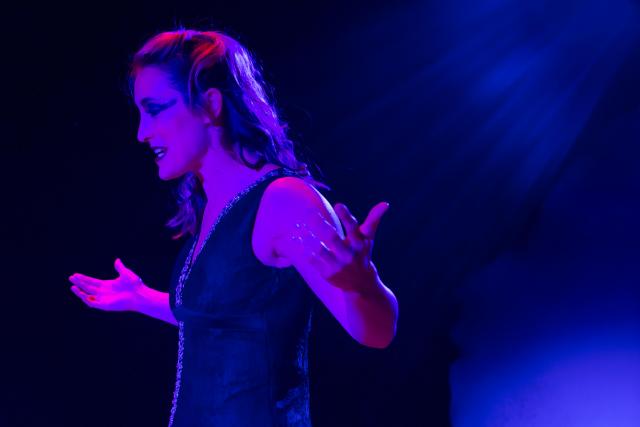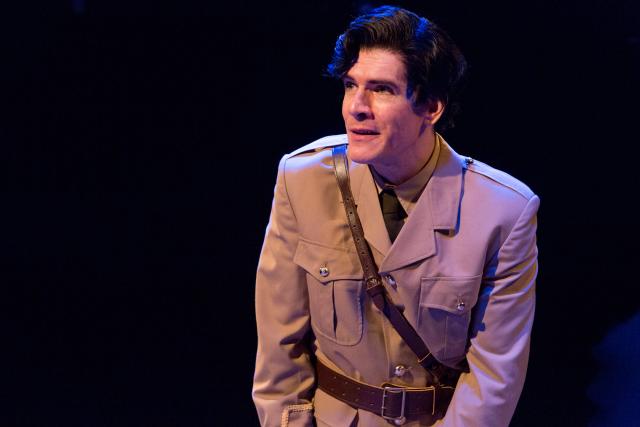

At The Sheen Center for Thought and Culture, off off Broadway, Blackfriars Repertory Theater and Storm Theater Company are presenting Death Comes for the War Poets. It calls itself “a dramatic verse tapestry,” and the phrase describes the piece well. It is composed of the poetry of Siegfried Sassoon and Wilfred Owen, with additional verse by Joseph Pearce. It’s wonderful to see a show almost entirely in verse. Three characters populate this play. Sassoon and Owen, of course, and the third character is Death herself. I use the feminine pronoun because director Peter Dobbins has cast as Death a young, pretty actress. It’s a great choice. Indeed, for Sassoon and Owen, death – their own deaths – must have been a seductive alternative to the hideous life they led and witnessed in World War One. It’s a creative miracle that they transformed the horror they saw in the trenches into art. It’s a matter of opinion which was the better poet, but they both wrote poems that are brutal in their genesis and beautiful in their truthfulness. Nicholas Carriere plays the role of Sassoon, and Michael Raver plays Owen. They’re both absolutely terrific. Much of the stage time is spent with one or the other reciting verse, and their readings of the poems are marvelous. They recite with great intensity, involvement and animation, giving the words much color. This isn’t the only way – or even the best way – to recite poetry, but Messrs. Carriere and Raver are so talented, and they work with such meticulous discipline, that their work is inarguably very fine. Mr. Raver even manages to be eloquent reciting the poems with Owen’s stammer. Mr. Carriere and Mr. Raver aren’t given much opportunity to act, technically, but there’s a brief prose dialogue between the two that they handle with great skill. As Death, Sarah Naughton is as skillful as the two men on stage, but she has less interesting material to work with. Her reading of the verse she’s been given is excellent, more reserved than the readings of the men but no less expressive. When she kisses them, it’s as if death is a sensuous coupling. Mr. Dobbins has directed this highly formal piece very well, delicately, expressively but without showiness. He’s directed the verse in a very dramatic way, and he’s cast actors who are up to the challenge. He’s even managed to cast actors who look like the actual people they’re playing. Unfortunately, he’s built a platform in the shape of a cross for the stage, so that we look up, with an artificial perspective. He would have done well to define the space on the floor. The audience, after all, is only a few rows deep. Joseph Pearce’s script concentrates on Sassoon considerably more than on Owen. There’s a terrific scene between the two – the only scene in the play that assuredly contains a specific time and place – that takes place in the War Hospital where the two poets met. This is where they have that prose dialogue. Following that, the actors alternate speaking in a celebration of the poems. Mr. Pearce also makes much of Sassoon’s prose piece, “Finished with the War: A Soldier’s Declaration,” his renunciation of war that was read out in Parliament and got him confined to the war hospital as a victim of “shell shock.” "I believe that this War is being deliberately prolonged by those who have the power to end it." An insightful observation – and familiar. Mr. Pearce is very clever to include it. Mr. Pearce’s own verse, given largely or exclusively to Death, weaves together the older poems from Sassoon and Owen. It’s nice enough but unremarkable. I suppose Death has to say “So soon, Sassoon,” but the playwright has her say it twice. Death also has some lines from other poets – T.S. Eliot (the opening of “The Waste Land”) and Rupert Brooke (“The Soldier”), and others. The playwright is throwing rather too much at us, here, but we enjoy listening to them in Ms. Naughton’s lovely voice. Mr. Pearce would also do well to cut a short digression into Sassoon’s admission of a minor plagiarism. The same applies to the passage from “Lenten Illuminations,” which Sassoon wrote after he converted to Catholicism, a letter to his former, unconverted self. Mr. Pearce doesn’t really give enough shape to the raw material he’s chosen. It’s the Sassoon and Owen poems themselves that keep us engaged – such as Sassoon’s “Arcady Unheeding” and Owen’s “Anthem for Doomed Youth.” Death does indeed come for Sassoon at the end, but Owen disappears from the stage too soon, and we’d like to see the play more balanced between the two. The Archbishop Fulton J. Sheen Center is a project of The Archdiocese of New York, and the play has Catholic concerns. According to the program, Death Comes for the War Poets is concerned with Sassoon’s conversion, although the script doesn’t speak for itself on this point. Siegfried Sassoon outlived World War II. Wilfred Owen returned to the front after leaving the war hospital and was killed during the last week of the war.
